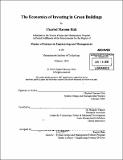The economics of investing in green buildings
Author(s)
Rizk, Charbel Maroun
DownloadFull printable version (21.32Mb)
Other Contributors
System Design and Management Program.
Advisor
Ricardo Valerdi.
Terms of use
Metadata
Show full item recordAbstract
This thesis discusses economics of green buildings. The need to reduce greenhouse gases emissions became clear. Buildings account for a large part of the greenhouse gases emissions, changing the atmosphere's composition. Climate changes will be unevenly distributed between regions; in early stages they might be beneficial for few but will eventually end up being costly for all. Several worldwide rating systems were established with a common objective to determine metrics for measuring a building's performance and minimizing environmental footprint. In this research we selected LEED-NC version 2.2 by U.S. Green Building Council (USGBC) for our analysis. V-2.2 consists of a set of credits distributed in categories. We identified credit's requirements and analyzed their impact on cost and environment. We supported our analysis by looking into cost and benefit studies performed by different organizations, and summarized our findings in providing heuristics on green buildings. Finally, a major take away from this research project is that there are numerous factors affecting difficulty of achieving, cost, and benefits of LEED credits. In addition to that, the correlation between credits and the large number of combinations to qualify for LEED certification levels, make it unreasonable to generalize about the incremental cost for any certification level.
Description
Thesis (S.M. in System Design and Management)--Massachusetts Institute of Technology, Engineering Systems Division, 2010. Cataloged from PDF version of thesis. Includes bibliographical references (p. 144-147).
Date issued
2010Department
System Design and Management Program.; Massachusetts Institute of Technology. Engineering Systems DivisionPublisher
Massachusetts Institute of Technology
Keywords
Engineering Systems Division., System Design and Management Program.